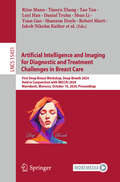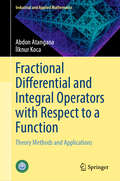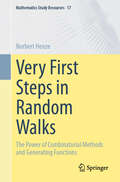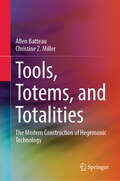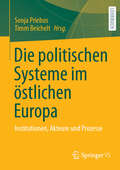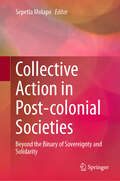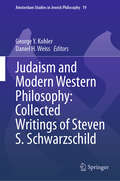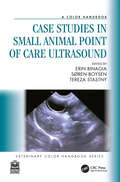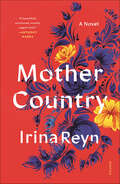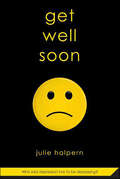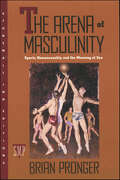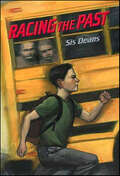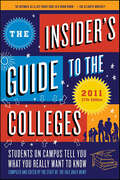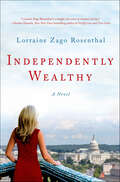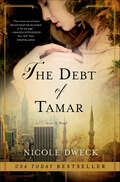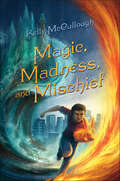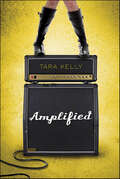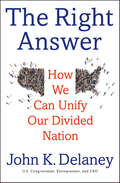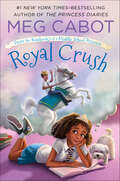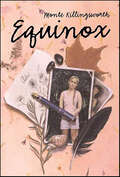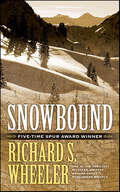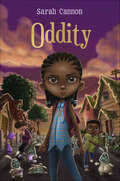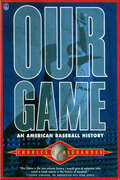- Table View
- List View
Zeitarbeit und Personaldienstleistungen: Chancen - Erfahrungen - Herausforderungen
by Markus-Oliver Schwaab Ariane DurianDie 3., vollständig überarbeitete und aktualisierte Auflage gibt einen zugleich wissenschaftlich fundierten und praxisnahen Überblick über die Zeitarbeit und die angrenzenden Personaldienstleistungen in Deutschland. Sie beschreibt die Entwicklung dieser wichtigen Branche, die rechtlichen Rahmenbedingungen, die zentralen Akteure und innovative Lösungen. Beleuchtet werden aus unterschiedlichen Perspektiven in über 30 Beiträgen auch die Chancen und Risiken, die mit der Zeitarbeit als Beschäftigungsform verbunden sind. Die relevanten Interessengruppen kommen zu Wort: Wissenschaftler, Personalmanager, Personaldienstleister, Volks- und Betriebswirte, Juristen, aber auch Vertreter aus Verbänden und Gewerkschaften.
Artificial Intelligence and Imaging for Diagnostic and Treatment Challenges in Breast Care: First Deep Breast Workshop, Deep-Breath 2024, Held in Conjunction with MICCAI 2024, Marrakesh, Morocco, October 10, 2024, Proceedings (Lecture Notes in Computer Science #15451)
by Yuan Gao Shuo Li Shandong Wu Ritse M. Mann Tianyu Zhang Tao Tan Luyi Han Danial Truhn Shannon Doyle Robert Martí Marly Jakob Nikolas Kather Katja Pinker-Domenig Geert LitjensThis book constitutes the refereed proceedings of the First Deep Breast Workshop on Artificial Intelligence and Imaging for Diagnostic and Treatment Challenges in Breast Care, Deep-Breath 2024, held in conjunction with the 26th International Conference on Medical Imaging and Computer-Assisted Intervention, MICCAI 2024, in Marrakesh, Morocco, on October 10, 2024.The 23 regular papers presented in this book were carefully reviewed and selected from 51 submissions.The workshop provides an international platform for presentation of - and discussion on - studies related to AI in breast imaging. Deep-Breath aims to promote the development of this research area by sharing insights in academic research and clinical practice between clinicians and AI experts, and by exploring together the opportunities and potential challenges of AI applications in breast health. The deep-breath workshop provides, therefore, an unique forum to discuss the possibilities in this challenging field, aiming to create value that eventually truly leads to benefit for physicians and patients.
Fractional Differential and Integral Operators with Respect to a Function: Theory Methods and Applications (Industrial and Applied Mathematics)
by Abdon Atangana İlknur KocaThis book explores the fundamental concepts of derivatives and integrals in calculus, extending their classical definitions to more advanced forms such as fractional derivatives and integrals. The derivative, which measures a function's rate of change, is paired with its counterpart, the integral, used for calculating areas and volumes. Together, they form the backbone of differential and integral equations, widely applied in science, technology, and engineering. However, discrepancies between mathematical models and experimental data led to the development of extended integral forms, such as the Riemann–Stieltjes integral and fractional integrals, which integrate functions with respect to another function or involve convolutions with kernels. These extensions also gave rise to new types of derivatives, leading to fractional derivatives and integrals with respect to another function. While there has been limited theoretical exploration in recent years, this book aims to bridge that gap. It provides a comprehensive theoretical framework covering inequalities, nonlinear ordinary differential equations, numerical approximations, and their applications. Additionally, the book delves into the existence and uniqueness of solutions for nonlinear ordinary differential equations involving these advanced derivatives, as well as the development of numerical techniques for solving them.
Computational Intelligence in Communications and Business Analytics: 6th International Conference, CICBA 2024, Patna, India, January 23–25, 2024, Revised Selected Papers, Part I (Communications in Computer and Information Science #2366)
by Paramartha Dutta Somnath Mukhopadhyay Amit Kumar Singh Jyoti Prakash Singh Jyotsna K. Mandal Maheshwari Prasad SinghThis three-volume set CCIS 2366-2368 constitutes the refereed proceedings of the 6th International Conference on Computational Intelligence in Communications and Business Analytics, CICBA 2024, held in Patna, India, during January 23–25, 2024. The 82 full papers presented in this volume were carefully reviewed and selected from 249 submissions. Together, these papers showcase cutting-edge research in the fields of computational intelligence and business analytics, covering a broad range of topics.
Very First Steps in Random Walks: The Power of Combinatorial Methods and Generating Functions (Mathematics Study Resources #17)
by Norbert HenzeWith this book, which is based on the third edition of a book first written in German about random walks, the author succeeds in a remarkably playful manner in captivating the reader with numerous surprising random phenomena and non-standard limit theorems related to simple random walks and related topics. The work stands out with its consistently problem-oriented, lively presentation, which is further enhanced by 100 illustrative images. The text includes 53 self-assessment questions, with answers provided at the end of each chapter. Additionally, 74 exercises with solutions assist in understanding the material deeply. The text frequently engages in concrete model-building, and the resulting findings are thoroughly discussed and interconnected. Students who have tested this work in introductory seminars on stochastics were particularly fascinated by the interplay of geometric arguments (reflection principle), combinatorics, elementary stochastics, and analysis. This book is a translation of an original German edition. The translation was done with the help of artificial intelligence. A subsequent human revision was done primarily in terms of content, so that the book will read stylistically differently from a conventional translation.
Tools, Totems, and Totalities: The Modern Construction of Hegemonic Technology
by Allen Batteau Christine Z. MillerThis book provides a critical perspective on technology, answering the questions of why technologies often disappoint. It takes a sociotechnical and historical perspective on technology, as developed by an engineer–anthropologist and a design anthropologist, to answer questions not only about why modern societies have great expectations of technology, but also of why these technologies often fail to meet expectations. Modern societies often search for technological solutions (“technofixes”) to what are institutional problems, which include border crossings or urban mobility, or improvements in productivity or improved communication. It is disappointing when technofixes, whether border walls or driverless cars or social media, fail to live up to their promises of greater personal autonomy (such as afforded by driverless cars) or improved social harmony through social media. Examining technology from the perspectives of instrumentality (“tools”), identity (“totems”), and world-defining systems (“totalities”) develops a comprehensive perspective that is at once historically informed and cross-culturally accurate. Although instrumentality is obvious and is at the core of any understanding of technology, identity is less so; yet many modern “tribes” create their identity in terms of technological objects and systems, whether transport systems (cars and airplanes) or social media or weapons (guns). Further, modern technologies span the globe, so that they exert imperative coordination over distant populations; the use of cell phones around the world is testimony to this fact. Such a critical perspective on technology can be useful in policy discussions of numerous issues affecting contemporary institutions.
Die politischen Systeme im östlichen Europa: Institutionen, Akteure und Prozesse
by Timm Beichelt Sonja PriebusDas Buch bietet eine vergleichende Darstellung der politischen Systeme der Staaten des östlichen Europa, d.h. aller Staaten in Mittel-, Ost- und Südosteuropa. Die insgesamt 22 Länderkapitel beschreiben und analysieren zentrale Institutionen wie Parlament, Regierung, Staatspräsident und das Wahlsystem. Um der starken Dynamik von Transformation und Post-Transformation Rechnung zu tragen, wird auch die soziale und historische Einbettung der Institutionen beleuchtet. Das Buch richtet sich an Studierende der Politikwissenschaft sowie an alle Personen, die sich für die dynamischen politischen Entwicklungen im Osten Europas interessieren.
Collective Action in Post-colonial Societies: Beyond the Binary of Sovereignty and Solidarity
by Sepetla MolapoThis book offers an exploration of collective action by bringing together the themes of sovereignty and solidarity in post-colonial societies in Africa and beyond. It does so against a common tradition of writing about collective action that assumes an opposition between the state as a legal framework of unity and social movements that express the aspirations of marginalized people. The book’s examination of collective action resists this binary division. It states that sovereignty can be imagined beyond the confines of the law and consequently beyond the centrality of the state. Power therefore appears as a construct of forces and factors that signal or gesture to a complex but fascinating way of imagining collective action. These forces and factors open our eyes to the dynamics of life in post-colonial societies in ways that the understanding of sovereignty centred on law conceals. Brought into an intimacy with solidarity, sovereignty opens collective action to nuanced, complex and multiple configurations that surpass binary thinking. This is an innovative approach and of interest to students and scholars from across the social sciences.
Judaism and Modern Western Philosophy: Collected Writings of Steven S. Schwarzschild (Amsterdam Studies in Jewish Philosophy #19)
by Steven S. SchwarzschildWhat are the implications of Franz Rosenzweig's quasi-racialist commonalities with Heidegger's thought? Was Kant a 'Jewish thinker'? Does Spinoza's philosophy lend support to totalitarianism? Was Marx's philosophy more shaped by Jewish cultural tradition than is typically assumed? Was there a strong challenge to Strauss's reading of Maimonides already in the 1940s? This volume contains a collection of Steven S. Schwarzschild's (1924-1989) most important unpublished works, the majority of which were found in his literary remains. The essays present provocative perspectives on influential philosophical figures such as Maimonides, Spinoza, Kant, Hegel, Marx, Rosenzweig, Heidegger, and Leo Strauss. As one of the most original twentieth-century thinkers in the field of Jewish philosophy, Schwarzschild's analysis provides readers with new ways of understanding modern Western philosophy, Jewish religious tradition, and the relation between them.
Case Studies in Small Animal Point of Care Ultrasound: A Color Handbook (Veterinary Color Handbook Series)
by Erin Binagia, Søren Boysen, Tereza StastnyThis illustrated practical guide covers the many facets of small animal point-of-care ultrasound (POCUS) using clinical cases commonly seen in practice. It details specific point-of-care ultrasound techniques, views, interpretations, pitfalls and knowledge gaps, highlighting the utility of initial and serial POCUS for both diagnostic and patient management purposes. Divided into seven sections, the book covers ultrasound of the pleural space and lungs, heart, and abdomen, as well as the Caudal Vena Cava Collapsibility Index (CVC-CI), miscellaneous and advanced cases.Authored by leading authorities in the field, this guide recognizes the strengths of POCUS in screening and monitoring while also highlighting the limitations of using it as a sole diagnostic tool. Focusing on commonly asked questions and applications, the authors take a binary question approach to veterinary POCUS, which has been shown to decrease errors in human POCUS.Case videos to accompany Chapters 4, 5, 7, 9, 11, 13 and 15 are available on the book’s Companion Website at https://routledgetextbooks.com/textbooks/9780367547257/. These can be accessed directly on a smartphone using the QR codes in the relevant chapters.This full-colour handbook is the ideal reference for small animal and mixed practitioners, including general veterinary practitioners, emergency veterinarians, interns, residents and veterinary students.
Mother Country: A Novel
by Irina ReynStarred reviews from Library Journal and Publishers WeeklyAward-winning author Irina Reyn explores what it means to be a mother in a world where you can't be with your child Nadia's daily life in south Brooklyn is filled with small indignities: as a senior home attendant, she is always in danger of being fired; as a part-time nanny, she is forced to navigate the demands of her spoiled charge and the preschooler's insecure mother; and as an ethnic Russian, she finds herself feuding with western Ukrainian immigrants who think she is a traitor. The war back home is always at the forefront of her reality. On television, Vladimir Putin speaks of the "reunification" of Crimea and Russia, the Ukrainian president makes unconvincing promises about a united Ukraine, while American politicians are divided over the fear of immigration. Nadia internalizes notions of "union" all around her, but the one reunion she has been waiting six years for - with her beloved daughter - is being eternally delayed by the Department of Homeland Security. When Nadia finds out that her daughter has lost access to the medicine she needs to survive, she takes matters into her own hands. Mother Country is Irina Reyn's most emotionally complex, urgent novel yet. It is a story of mothers and daughters and, above all else, resilience.
Get Well Soon
by Julie HalpernAnna Bloom is depressed -- so depressed that her parents have committed her to a mental hospital with a bunch of other messed-up teens. Here she meets a roommate with a secret (and a plastic baby), a doctor who focuses way too much on her weight, and a cute, shy boy who just might like her.But wait! Being trapped in a loony bin isn't supposed to be about making friends, losing weight, and having a crush, is it? Get Well Soon, Julie Halpern's fiction debut, finds humor in the unlikeliest of places, and presents a character whose voice -- and heart -- will resonate with all of us who have ever felt just a little bit crazy.
The Arena of Masculinity: Sports, Homosexuality, and the Meaning of Sex
by Brian ProngerSports are perhaps the most visible expression of the ideals of masculinity in our society, and figure as a training ground on which young boys are taught what it means to be a man. Given the involvement of sports with masculinity, the homosexual athlete becomes a paradox, and the recent explosive growth of gay sporting leagues, a puzzle.Pronger explores the paradoxical position of the gay athlete in a straight sporting world, examines the homoerotic undercurrent subliminally present in the masculine struggle of sports, and explicates the growth of gay sports in the framework of the developing gay culture.
Racing the Past
by Sis DeansA moving story about survival, recovery, and the power of determination.There was something else driving Ricky as he sped down Ridge Road under that cloudless blue sky. "Everybody knows a Gordon's middle name is Thief." The hatred and hurt rose up inside him. His stride lengthened. His arms pumped faster. He could feel the new-found fuel burning in his muscles. Today would be the day Ricky beat the bus."The best thing your father ever did was get himself killed."Though he'd never admit it out loud, secretly Ricky Gordon agrees. It's been three months since his dad's fatal car accident, but Ricky is still haunted by memories of violent beatings and hurtful words. His mind won't let him forget, and neither will the kids at school. And if Ricky gets into one more fight he'll be in serious trouble. The fights always begin on the bus. That's where the kids corner Ricky, teasing him until he's so angry that he hits back. There has to be another way to get to school. Ricky decides to try running.At first the three-mile run is pure torture, but soon he begins to build speed and stamina. It's not long before people notice his dedication and his talent. And finally he accepts the challenge that has been facing him all along: he will race the bus -- and win.
The Insider's Guide to the Colleges, 2011: Students on Campus Tell You What You Really Want to Know
by The Yale Daily NewsFor more than thirty-five years, The Insider's Guide to the Colleges has been the favorite resource of high school students across the country because it is the only comprehensive college reference researched and written by students for students. In interviews with hundreds of peers on campuses from New York to Hawaii and Florida to Alaska, our writers have sought out the inside scoop at every school on everything from the nightlife and professors to the newest dorms and wildest student organizations. In addition to the in-depth profiles of college life, this 37th edition has been revised and updated to include:* Essential statistics for every school, from acceptance rates to the most popular majors* A "College Finder" to help students zero in on the perfect school * Insider's packing list detailing what every college student really needs to bring* FYI sections with student opinions and outrageous off-the-cuff advice. The Insider's Guide to the Colleges cuts through the piles of brochures to get to the things that matter most to students, and by staying on top of trends and attitudes it delivers the straight talk students and parents need to choose the school that's the best fit.
Independently Wealthy: A Novel
by Lorraine Zago RosenthalIn Lorraine Zago Rosenthal's sequel to New Money, Savannah Morgan delves into the mystery of her late media mogul father's death and uncovers more than she ever expected.In New Money, Savannah Morgan was thrust into high society New York when she learned she was the sole heir to her media mogul father's billion dollar fortune. In Independently Wealthy she is living her dream life on the Upper West Side, excelling at her job as an editorial assistant, and enjoying her handsome new boyfriend, Alex.Everything in Savannah's life should be perfect—except she can't ignore the mystery of her father's death. Her hopes of solving this complicated and dangerous mystery are shared by Caroline Stone—her newfound sister who is slowly becoming a friend. Savannah decides to investigate, but not everyone wants Savannah to know the truth. Her domineering older brother, Ned has his own problems, including a lingering regret over his recent divorce, the constant pressure of running the Stone media empire, and managing a playboy bachelorhood. As Savannah's quest for the truth becomes more complicated and dangerous she is led to Washington, D.C., an alluring stranger, and more surprises, trouble, and changes than she ever could have imagined.Readers will be swept away by Savannah Morgan once again as she unravels the mystery of her father's death on Capitol Hill with all the charm and perseverance of when she first arrived in New York City.
The Debt of Tamar: A Novel
by Nicole DweckA USA TODAY Best seller!Bestselling author Nicole Dweck brings to life one of history's greatest yet overlooked stories of love and resilience.In 2002, thirty-two-year-old Selim Osman, the last descendant of Ottoman Sultan Suleiman the Magnificent, flees Istanbul for New York. In a twist of fate he meets Hannah, the daughter of a Holocaust survivor and an artist striving to understand a father she barely knows. Unaware that the connection they share goes back centuries, the two feel an immediate pull to one another. But as their story intertwines with that of their ancestors, the heroic but ultimately tragic decision that bound two families centuries ago ripples into the future, threatening to tear Hannah and Selim apart.From a 16th-century harem to a seaside village in the Holy Land, from Nazi-occupied Paris to modern-day Manhattan, Nicole Dweck's The Debt of Tamar weaves a spellbinding tapestry of love, history, and fate that will enchant readers from the very first page.
Magic, Madness, and Mischief
by Kelly McCulloughFrom the author of School for Sidekicks comes a witty and thoughtful middle-grade fantasy about the bonds of family and the strength of true friendship. Kalvan Monroe is worried. Either he’s going mad or he really did wake up with uncontrollable fire magic and accidentally summon a snarky talking fire hare. (Yes, that’s right, a hare. Made of fire. That talks.) He’s got to be going crazy, right? But if he’s not, then magic actually is real, and he’s got even more problems to worry about. Because Kalvan isn’t the only one with powers. The same fire magic that allows him to talk his way into and out of trouble burned too brightly in his mother, damaging her mind and leaving her vulnerable to the cold, manipulative spells of the Winter King. Can Kalvan gain control of his power in time to save his mother, or will their fires be snuffed out forever?Kelly McCullough combines Magic, Madness, and Mischief--as well as danger--in a delightful fantasy set in a magical version of St. Paul, Minnesota.
Amplified
by Tara KellyWhen privileged 17-year-old Jasmine gets kicked out of her house, she takes what is left of her savings and flees to Santa Cruz to pursue her dream of becoming a musician. Jasmine finds the ideal room in an oceanfront house, but she needs to convince the three guys living there that she's the perfect roommate and lead guitarist for their band, C-Side. Too bad she has major stage fright and the cute bassist doesn't think a spoiled girl from over the hill can hack it. . . .In this fresh new novel by critically acclaimed author Tara Kelly, Jasmine finds out what happens when her life gets Amplified.
The Right Answer: How We Can Unify Our Divided Nation
by John K. DelaneyThe first declared candidate for president in 2020 delivers a passionate call for bipartisan action, entrepreneurial innovation, and a renewed commitment to the American ideaThe son of a union electrician and grandson of an immigrant, John K. Delaney grew up believing that anything was possible in America. Before he was fifty, he founded, built and then sold two companies worth billions of dollars. Driven by a deep desire to serve, in 2012 he stepped away from his businesses, ran for Congress, and won. Now he has a new mission: unifying our terribly divided nation and guiding it to a brighter future. As a boy, Delaney learned the importance of working hard, telling the truth and embracing compromise. As an entrepreneur, he succeeded because he understood the need to ensure opportunity for all, focus on the future, and think creatively about problem-solving. In these pages, he illustrates the potency of these principles with vivid stories from his childhood, his career in business, his family, and his new life as a politician. He also writes candidly about the often frustrating experience of working on Capitol Hill, where many of his colleagues care more about scoring political points than improving the lives of their fellow Americans. With a clear eye and an open heart, he explains that only by seeing both sides of anargument and releasing our inner entrepreneur can we get back to constructive, enlightened governing.Seventy years ago, John F. Kennedy appealed to our best instincts when he said, “Let us not seek the Republican answer or the Democratic answer but the right answer.” In this inspiring book, John K. Delaney asks all of us to cast aside destructive, partisan thinking and join him in an urgent endeavor: working together to forge a new era of American greatness.
Royal Crush: From the Notebooks of a Middle School Princess (From the Notebooks of a Middle School Princess #3)
by Meg CabotGet ready for a Royal Crush in this third book in the middle-grade Princess Diaries spin-off series, written and illustrated by New York Times-bestselling author Meg Cabot.Olivia Grace Clarisse Mignonette Harrison is turning thirteen. Even better, she’s finally starting to get the hang of this princess thing. Just in time, too, since her half-sister, Princess Mia Thermopolis, is expected to give birth to twins any day now! It’s pretty much the worst time possible for a school field trip, but everyone is insisting that Olivia must attend the Royal School Winter Games. Between Grandmère chaperoning, Olivia’s snobby cousin Luisa complaining about her relationship woes, and everyone insisting that Olivia has a crush on Prince Khalil (even though she isn’t sure that he even wants to be friends anymore!), things are quickly turning into a royal mess! Praise for the FROM THE NOTEBOOKS OF A MIDDLE SCHOOL PRINCESS series: “The nation of Genovia gains a new resident in this amusing spin-off. . . . Cabot’s own black-and-white cartoons further enliven Olivia’s entertaining and candid notebook entries, which will have readers looking forward to her future escapades.” —Publishers Weekly on From the Notebooks of a Middle School Princess“A sweet fantasy, both funny and highly satisfying.” —Kirkus Reviews on From the Notebooks of a Middle School PrincessRead the whole series!From the Notebooks of the Middle School PrincessRoyal Wedding Disaster: From the Notebooks of a Middle School PrincessRoyal Crush: From the Notebooks of a Middle School Princess
Equinox
by Monte KillingsworthAutumn struggles to keep her fractured family from leaving their island home -- and each other -- until she learns that love and change grow side by side."There are some things you don't have to think about, things that are simple and solid. Leaving this island is one of those. I can't leave the island. If I do, I will no longer be me."Autumn and her parents live on a small island in the state of Washington. The slow, natural pace of her island home has always meant a great deal to Autumn, so when her father tells her that they must move to the commercial mainland, Autumn is devastated. Autumn sets out to prove to her parents how important it is for them to stay. In the course of creating an illustrated journal that highlights the wonderful things about the island, Autumn uncovers a secret about her mother that turns her world upside-down.With poetic prose and deftly painted imagery, Monte Killingsworth tells the story of a fourteen-year-old girl in a time of upheaval, when what once seemed certain -- Autumn's island life, her parents' love for each other, her family's future -- all comes into question. But with those questions begins a new understanding: that simplicity can be misleading, and that loving may include letting go.
Snowbound
by Richard S. WheelerIn this powerful biographical novel, Richard Wheeler—winner of the Owen Wister Lifetime Achievement Award and five Spur Awards—tells the amazing tale of the American explorer and hero, John Fremont, and his attempt to find a railway route to the west along the 38th parallel. Trapped in the snowbound Colorado mountains, Fremont must fight his way out. He battles the frigid elements in a harrowing journey over the backbone of the continent. In this tale of desperate danger and fierce courage, Wheeler presents the reader with a survival saga par excellence—a struggle of man against man, man against nature, man against himself—and a novel you will never forget.At the Publisher's request, this title is being sold without Digital Rights Management Software (DRM) applied.
Oddity
by Sarah CannonJoin a tough eleven-year-old as she faces down zombie rabbits, alien mobs, and Puppet Cartels while trying to find her missing twin in Sarah Cannon's imaginative middle-grade debut, Oddity.Welcome to Oddity, New Mexico, where normal is odd and odd is normal.Ada Roundtree is no stranger to dodging carnivorous dumpsters, distracting zombie rabbits with marshmallows, and instigating games of alien punkball. But things haven’t been the same since her twin sister, Pearl, won the town’s yearly Sweepstakes and disappeared . . .Along with her best friend, Raymond, and new-kid-from-Chicago Cayden (whose inability to accept being locked in the gym with live leopards is honestly quite laughable), Ada leads a self-given quest to discover Oddity’s secrets, even evading the invisible Blurmonster terrorizing the outskirts of town.But one of their missions goes sideways, revealing something hinky with the Sweepstakes . . . and Ada can’t let it go. Because, if the Sweepstakes is bad, then what happened to Pearl?
Our Game: An American Baseball History
by Charles C. AlexanderThis entertaining history blends anecdote, incident, and analysis as it chronicles the story of our national pastime. Charles C. Alexander covers the advent of the first professional baseball leagues, the game's surge in the early twentieth century, the Golden Twenties and the Gray Thirties, the breaking of the color line in the late forties, and the game's expansion to its current status as a premier team sport. He describes changing playing styles and outstanding teams and personalities but also demonstrates the many connections between baseball--as game, sport, and business--and the evolution of tastes, values, and institutions in the United States.

